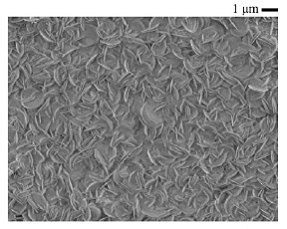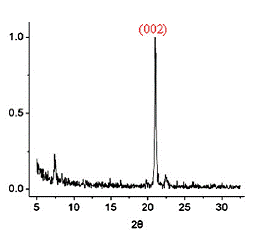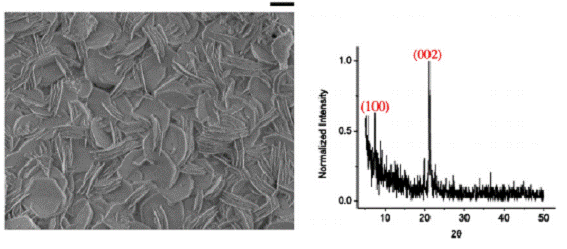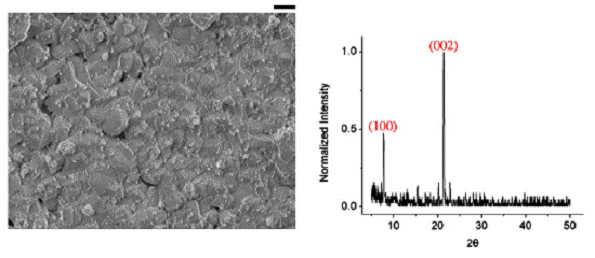
Back to Table of Contents
46427-AC10
Carbon Nanotube Membranes by Templated Growth in Oriented Molecular Sieve Films
Michael Tsapatsis, University of Minnesota
Carbon
nanotube membranes have recently attracted attention due to experiments and
simulations indicating extremely high fluxes.
If selective separations can also be demonstrated, these membranes will
be a major breakthrough in gas, liquid, and vapor separations with tremendous
implications in energy efficiency. This
research is aiming at the development of a carbon nanotube membrane by growing
submicron-thick, densely-packed, sub-nanometer diameter carbon nanotubes in the
interior of the pores of oriented aluminophosphate (AlPO4) molecular
sieve films. The AlPO4 films alone
are of interest because they can serve as highly selective membranes. Recent progress in our group includes the successful
growth of well-intergrown and appropriately-oriented AlPO4-5 and,
for the first time, submicron-thick CoAPO-5 films to be used as catalytic
supports for the templated growth of carbon nanotubes. With
these films as hosts for carbon nanotube growth, it is possible that membranes
with unprecedented performance will be the ultimate outcome.To be useful as a catalytic host for the templated growth of carbon
nanotubes for separations applications, an aluminophosphate film must have
excellent coverage, high orientation, and reliable thickness control during
synthesis. An in situ approach to
unmodified silicon substrates produced AlPO4-5 films with good
orientation but poor coverage for low reaction temperatures and short growth
times, or good coverage but random orientation for higher temperatures and
longer growth times. To overcome these
deficiencies, a seeded growth was introduced which involved substrate
functionalization with 3-chloropropyltrimethoxysilane, deposition of AlPO4-5-related
particles on the functionalized substrates to form a seed layer, and secondary
(seeded) growth to form a continuous polycrystalline AlPO4-5 film. A schematic of the technique is shown in
Figure 1.

Figure 1. Schematic representation of the secondary growth technique for AlPO4-5 films (Karanikolos et al. Chem. Matr. 19 (2007) 792-797 and Micro. Meso. Matr. 115 (2008) 11-22). | |
Since AlPO4-5 structures consist of one-dimensional straight
channels with pore openings 7.3Å in cross-section running along the c-
crystallographic axis, it is desirable to obtain c-oriented AlPO4
films. For such a film, the reaction
must be stopped before intergrowth of misoriented crystals becomes
dominant. To suppress nucleation/growth
and make the conditions for film formation more controllable, we introduced an
initial heating treatment of the precursor mixture, and subsequently used the
pre-treated solution for secondary growth on seeded silicon substrates. Figure 2 shows the result of such an
experiment for a secondary growth time of 1.5 hours. The crystals have an average size of 1μm
and cover the substrate completely, forming a well-intergrown film with an
average thickness of 500nm.




Figure 2. Scanning electron microscopy image (SEM, left) and x-ray diffraction pattern (XRD, right) of an AlPO4-5 film indicating excellent coverage and high orientation, respectively (Karanikolos et al. Micro. Meso. Matr. 115 (2008) 11-22). | |
To investigate the effect of the
structure-directing agent in the formation and morphology of AlPO4-5
films, experiments were performed using a variety of secondary growth times
after substituting for triethylamine (TEA) by tripropylamine (TPA). The results indicated that an average crystal
thickness of less than 50nm was obtained using TEA, while the crystal thickness
was increased to approximately 300nm when TPA was used. The overall thickness of the film was
unchanged during the use of TPA.
Seeded growth experiments were
performed to synthesize CoAPO-5 films through the use of a precursor solution
containing cobalt acetate tetrahydrate. Using TEA and TPA as structure-directing
agents, the results from Figure 3 indicate that well-intergrown and
submicron-thick cobalt-modified films have been achieved which display good
coverage and preferred c-orientation by a majority of the crystals. Again, substituting TEA by TPA yielded films
consisting of thicker crystals. For the
first time, submicron-thick CoAPO-5 films were fabricated. We are currently performing experiments using
fabricated AlPO4-5 and CoAPO-5 films as catalytic supports for the
templated growth of carbon nanotubes.


Figure. 3. SEM (left) and corresponding XRD (right) of CoAPO-5 films synthesized using TEA (top) and TPA (bottom) for secondary growth. The scale bars correspond to 1μm (Karanikolos et al. Micro. Meso. Matr. 115 (2008) 11-22). | |

The successful fabrications of submicron-thick, well-intergrown, and
highly-oriented AlPO4-5 and CoAPO-5 films have been
demonstrated. Although carbon nanotubes
formed in the pores of such hosts will be too small for most separations, the
seeded technique developed in our group can be used to synthesize films with
larger pore diameter frameworks, such as the 1.2nm diameter aluminophosphate
VPI-5. Introductory research has been
performed with VPI-5 and considerable future effort will focus on its
application toward oriented films and use as a host for carbon nanotube
growth. Additionally, research focused
directly on the templated growth of carbon nanotubes will continue using AlPO4-5
and CoAPO-5 films. This work is
performed in collaboration with Professor Avelino Corma of the Instituto de Tecnología Química and Dr. George Karanikolos
of the National Center for Scientific Research, Demokritos.
Back to top









